Kitchen Cabinets
- November 18, 2025
Measuring for RTA cabinets doesn't have to be complicated. Our step-by-step guide walks you through the entire process, from gathering tools to documenting every dimension. Learn how to get accurate measurements that ensure your cabinets fit perfectly the first time.
- November 13, 2025
Shopping for RTA cabinets but overwhelmed by options? We break down what actually makes cabinets high-quality, compare construction methods and materials, and help you identify which RTA options match your project needs and budget.
- November 11, 2025
Discover everything you need to know about RTA cabinets: cost savings, quality comparisons, assembly tips, and how to choose the right ready-to-assemble cabinets for your kitchen.
- September 01, 2025
How much does it cost to paint kitchen cabinets? We break down average prices, professional vs. DIY costs, and what factors impact your budget.
- August 30, 2025If your kitchen pantry cabinets are looking a little dated and worn, one option may be to invest in resurfacing or refacing as a substantially cheaper way to refresh and modernize your kitchen than replacing your cabinetry.
- August 07, 2025
Choosing between shallow and standard base cabinets can shape your kitchen’s style and function. This guide explains the differences and helps you decide which option works best for your space.
- August 04, 2025
Maximize small kitchen spaces with these storage ideas using shallow base cabinets. From utensil drawers to vertical dividers, these solutions keep your layout functional and stylish. Ideal for modern apartments and narrow galley kitchens.
- August 01, 2025
Galley kitchens can be efficient and elegant with the right layout. Learn how to plan your space with shallow base cabinets, tall units, and narrow wall storage.
- July 28, 2025
Working with limited kitchen space? Discover why 12-inch deep base cabinets are the smart solution. Learn how shallow cabinets improve flow, storage, and design.
- July 23, 2025
Shallow depth kitchen cabinets are ideal for tight spaces like galley kitchens, apartments, or pantries. Learn when and how to use them in your layout.












